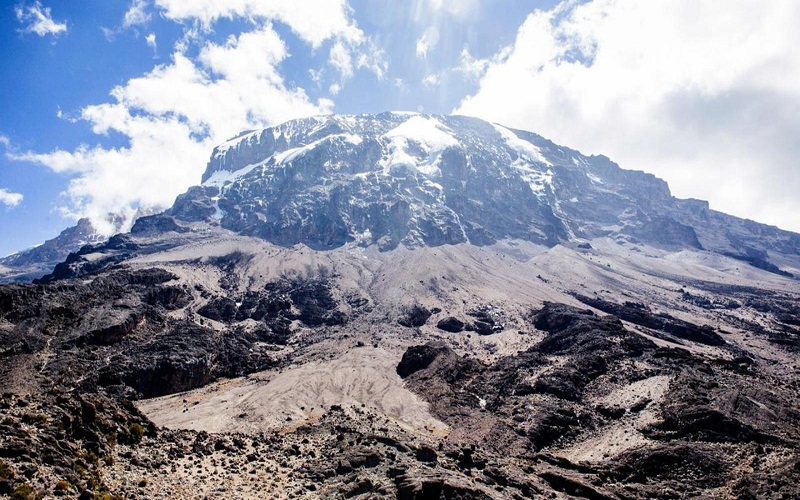
Mount Kilimanjaro's elevation of 5,895 meters (19,341 feet) makes it the highest point in Africa. It is one of the Seven Summits, making it a prestigious climb. The peak is formed by three volcanic cones: Kibo, Mawenzi, and Shira, with Kibo being the tallest.
Mount Kilimanjaro’s elevation of 5,895 meters (19,341 feet) places it as the highest mountain in Africa. Located in northeastern Tanzania, this iconic peak has long been a subject of fascination for mountaineers and nature enthusiasts alike. With its unique position near the equator, Kilimanjaro is a marvel of both geographical and ecological significance. The mountain is formed from three volcanic cones: [Kibo](w), [Mawenzi](w), and [Shira](w). While the entire massif is dormant, it remains an essential feature in East Africa's topography.
Standing at 5,895 meters, Mount Kilimanjaro is a towering symbol of natural beauty and challenge. As the tallest free-standing mountain in the world, it has attracted climbers for generations. Reaching the summit, [Uhuru Peak](w), is a dream for many who take on the climb through various routes, such as the [Machame Route](w), [Marangu Route](w), and others. Despite being located just south of the equator, Kilimanjaro's elevation supports diverse ecosystems ranging from lush rainforests at the base to alpine deserts at higher altitudes. This variation contributes to its ecological richness, making it a UNESCO [World Heritage Site](w).
Climbers seeking to reach the summit of Mount Kilimanjaro face a variety of options in terms of routes. Each route provides different experiences in terms of difficulty, scenic beauty, and trekking time. The most popular route is the [Machame Route](w), known for its stunning views and challenging terrain. The [Marangu Route](w), often referred to as the “Coca-Cola Route,” is considered more straightforward and accommodates those who prefer hut accommodations over camping. Whatever the route, reaching the summit is an accomplishment few will ever forget.
The weather on Mount Kilimanjaro varies dramatically as climbers ascend. At the base, the mountain experiences tropical climates, with lush forests and frequent rainfall. As you climb, the temperature drops, and the vegetation changes, with alpine meadows and rocky terrain replacing the rainforest. At the summit, temperatures can plummet to subzero levels, even during the dry season. Climbers are advised to prepare for extreme weather conditions and possible altitude sickness, which can affect individuals at higher elevations.
Mount Kilimanjaro hosts several distinct ecological zones as climbers ascend. The lower slopes are covered by lush rainforests, which provide a habitat for diverse wildlife, including monkeys, elephants, and various bird species. As the altitude increases, the vegetation changes, with moorland and alpine desert regions replacing the forests. The summit region, above 5,000 meters, is a barren, icy landscape. This variation in ecosystems makes Kilimanjaro a unique and biodiverse mountain, home to numerous endemic species.
The exact height of Mount Kilimanjaro is 5,895 meters (19,341 feet) above sea level. This makes it the highest mountain in Africa.
Mount Kilimanjaro is a dormant stratovolcano. While it is not currently erupting, its three volcanic cones—Kibo, Mawenzi, and Shira—are remnants of past volcanic activity. Kibo, the tallest cone, is the one that climbers ascend to reach the summit.
There are several routes to the summit of Mount Kilimanjaro, with the most popular being the Machame Route, the Marangu Route, the Lemosho Route, and the Rongai Route. Each offers a different experience in terms of scenery, difficulty, and duration.
Climbing Mount Kilimanjaro typically takes between 5 to 9 days, depending on the route chosen and the climber's acclimatization process. The longer treks give climbers better chances of safely reaching the summit by allowing more time for acclimatization to the altitude.
Yes, many people with no mountaineering experience climb Kilimanjaro successfully. However, it is crucial to be in good physical condition, follow proper acclimatization strategies, and have the right gear. Hiring a guide or joining an organized trek is strongly recommended for safety.
Mount Kilimanjaro is home to a variety of wildlife, especially on the lower slopes. Visitors can spot species such as elephants, buffalo, monkeys, and a diverse range of birds. As the climb progresses, the wildlife becomes less abundant due to the harsher climate at higher altitudes.
The best times to climb Mount Kilimanjaro are during the dry seasons, from January to mid-March and June to October. These months offer the clearest weather and the best chances of reaching the summit without encountering heavy rainfall.
Mount Kilimanjaro is not only the tallest mountain in Africa but also one of the most iconic and challenging climbs in the world. With its impressive elevation of 5,895 meters (19,341 feet), diverse ecosystems, and breathtaking views, it draws thousands of climbers each year. Whether you're an experienced mountaineer or a first-time hiker, climbing Kilimanjaro offers an unforgettable adventure. However, it’s essential to prepare thoroughly, respect the mountain’s challenges, and choose the right route to make the most of this incredible experience.